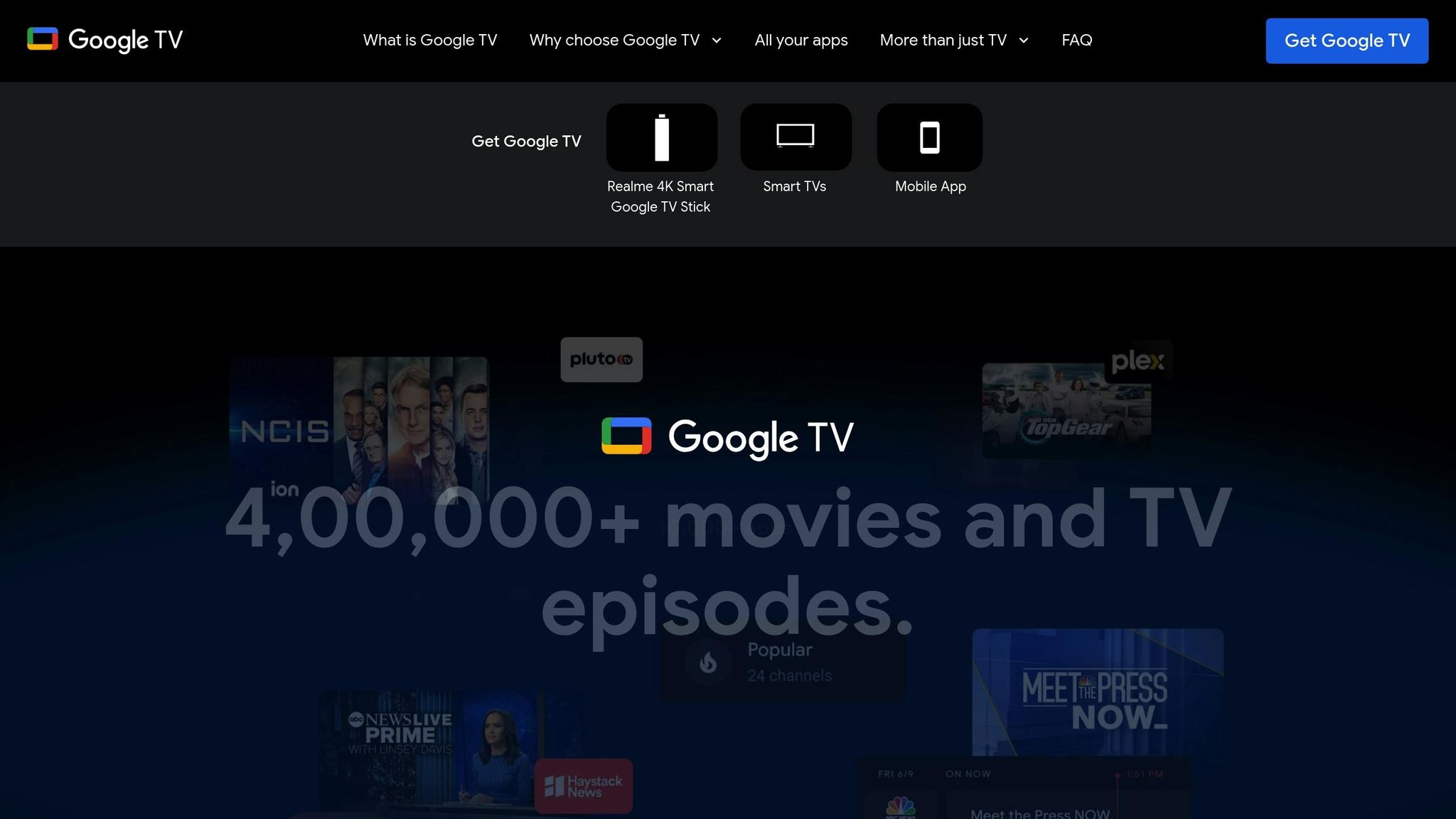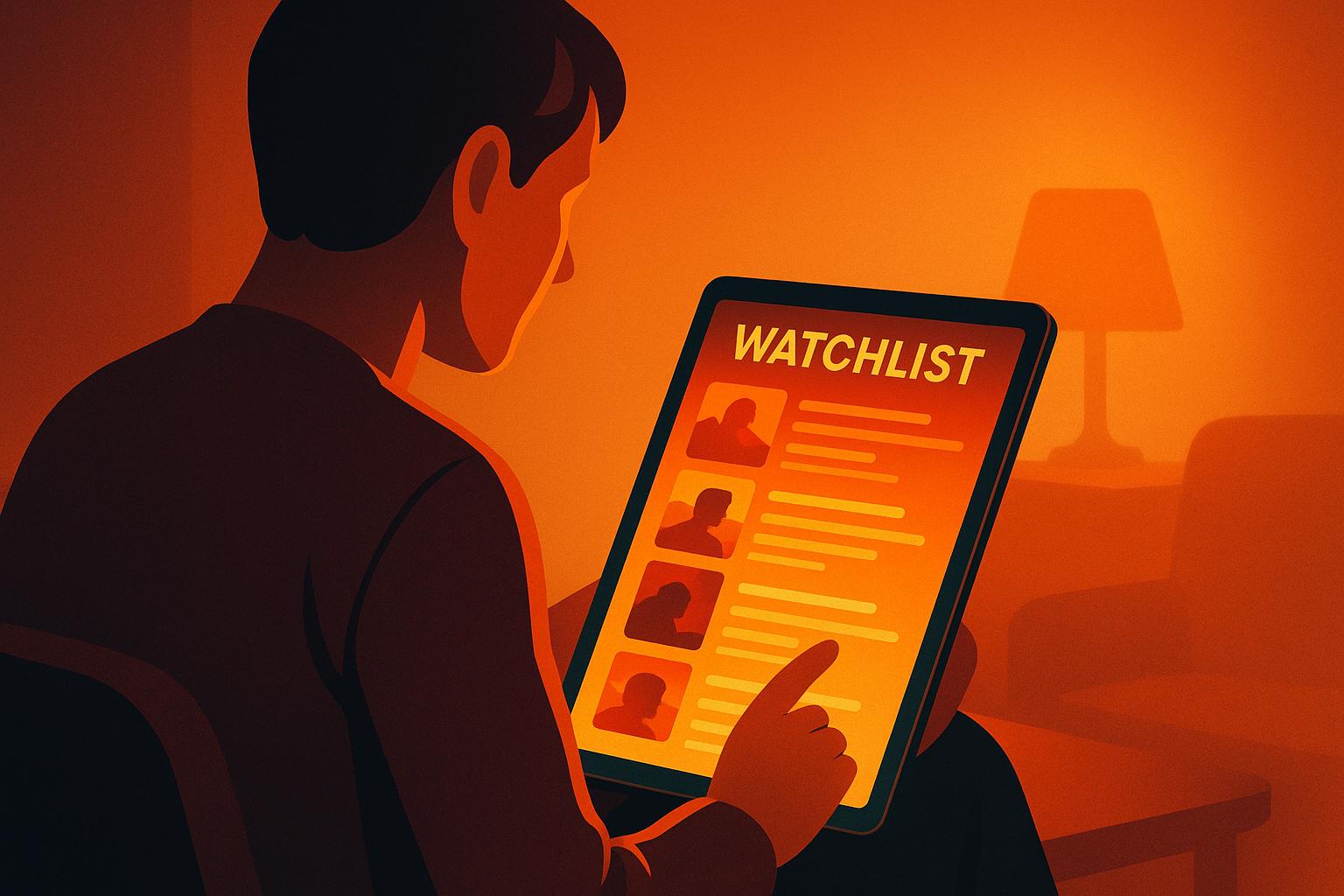Watchlist alerts have transformed how cinemas connect with audiences. These notifications let moviegoers receive updates about films they care about, bridging the gap between interest and action. Unlike older marketing methods like TV ads or email blasts, watchlist alerts focus on personalization, timing, and engagement, ensuring users only get updates they actually want.
Here’s why they work:
- Personalized Updates: Notifications are tailored to user preferences, like genre or showtime.
- Real-Time Alerts: Immediate updates on ticket sales, new showtimes, or special events.
- Higher Engagement: Users who opt in are more likely to act, boosting ticket sales.
While older methods still help spread awareness, watchlist alerts excel at converting interest into ticket purchases. Combining both approaches can maximize reach and engagement.
Google TV App Updated to Notify You When a Movie or TV Show in Your Watchlist is Free to Stream

1. Watchlist Alerts
Watchlist alerts are changing the way cinemas connect with their audiences. Instead of sending out generic messages to everyone, these systems focus on delivering targeted notifications to moviegoers who've already shown interest in specific films.
Engagement
What makes watchlist alerts so effective is their interactive nature. Unlike traditional one-way marketing methods, these alerts allow users to actively choose which films they want updates on. This shifts moviegoers from being passive recipients to active participants. Notifications about films they've personally selected are far more likely to grab attention, be opened, and lead to action. Filmgrail's mobile apps and websites take this engagement further by using interactive media when sending out these notifications, creating a more dynamic experience.
Personalization
These alerts are all about making the experience personal. Notifications are tailored to align with each user's preferences and behavior. For instance, a horror fan might get updates on midnight showings, while families might be notified about weekend matinees. Filmgrail adds an extra layer of relevance by including reviews and ratings from local audiences - people who attend the same cinema. This hyper-local approach makes the recommendations feel more relatable and trustworthy, enhancing the overall experience.
Timeliness
The real strength of watchlist alerts lies in their timing. When new showtimes are added, tickets go on sale, or special events are announced, subscribers are notified right away. This immediacy is crucial, especially for screenings that sell out quickly. Event-triggered alerts also ensure moviegoers stay informed about last-minute changes, like rescheduled or canceled screenings, keeping them in the loop and avoiding frustration.
Impact on Ticket Sales
These timely, personalized updates don’t just engage users - they also drive ticket sales. Watchlist alerts create a direct link between interest and purchase. Unlike traditional advertising, where it's hard to measure the connection between exposure and sales, these alerts offer clear attribution. Since the notifications target users who are already interested in a film, they often lead to higher conversion rates. Cinemas can also use analytics to track which alerts perform best, refining their strategies over time for even better results.
For example, Netflix's homepage placement and targeted notifications helped "Glass Onion" reach 35 million households in its first weekend.
This example highlights how delivering timely, personalized content can significantly boost engagement and ticket sales.
2. Standard Cinema Marketing Methods
For decades, traditional cinema marketing has leaned on broad-reaching strategies. While these methods aim to capture large audiences, they often fall short in building meaningful connections with individual moviegoers. This static approach feels outdated compared to the more dynamic and personalized options available today, such as watchlist alerts.
Engagement
Most traditional marketing methods rely on one-way communication. Think TV commercials, radio ads, newspaper spreads, and billboards. These formats push messages out to the masses without inviting any real interaction. The audience becomes passive, unable to share preferences or engage with the content in a way that feels personal.
Even social media, which has the potential to be more interactive, often struggles with low engagement rates. Cinema chains frequently post generic updates, promoting a wide variety of genres to all followers - many of whom may not be interested in certain films.
Email newsletters are another popular tool, but they often miss the mark. Why? They tend to feature general announcements about all upcoming films, with little to no segmentation. As a result, these emails are often ignored, deleted, or sent straight to spam.
Personalization
The lack of personalization is another major drawback of traditional marketing. These methods offer limited flexibility in tailoring messages to individual preferences. For example, TV and radio ads can target broad demographic groups based on time slots or programming, but they can’t account for personal tastes or viewing habits.
Print ads in newspapers and magazines allow for some targeting based on readership, but the approach is still too broad. A horror movie ad in a general entertainment magazine might reach readers who have no interest in the genre, while dedicated horror fans who don’t read that publication may never see it.
Timeliness
Timing is everything, and this is where traditional methods often falter. Campaigns typically follow rigid schedules that don’t always align with when moviegoers are most likely to act. For instance, a movie trailer might air weeks before tickets go on sale, leaving viewers to forget about the film by the time it’s available. On the flip side, information about limited releases might only surface after showtimes are already sold out.
These methods also struggle to adapt to last-minute updates. If showtimes change, special screenings are added, or events are canceled, there’s no quick way to notify audiences who were interested in those specific films.
Impact on Ticket Sales
Measuring the success of traditional cinema marketing is notoriously tricky. These campaigns often fail to directly link ad exposure to ticket sales. Cinemas pour resources into broad campaigns, but the cost per conversion tends to be high, with many impressions wasted on audiences who have no intention of attending a particular film.
Another issue is the longer conversion cycle. Traditional ads don’t provide a seamless path from awareness to purchase. Moviegoers must remember the ad, independently look up showtimes, and then navigate to ticketing platforms. Each extra step increases the likelihood that potential customers will drop off before buying a ticket.
sbb-itb-b1b0647
Pros and Cons
Let’s break down the strengths and limitations of watchlist alerts compared to traditional marketing approaches. Here’s a side-by-side comparison:
| Criteria | Watchlist Alerts | Standard Marketing Methods |
|---|---|---|
| Personalization | High – tailored to user interests | Low – broad, generic messaging |
| Engagement | High – real-time, relevant notifications | Variable – depends on channel and timing |
| Conversion Rate | Higher due to relevance and immediacy | Lower, often due to lack of targeting |
| Cost Efficiency | More efficient – targets interested users | Less efficient – higher spend, broad reach |
| User Experience | Positive if well-timed; risk of fatigue | Can be intrusive or ignored |
| Analytics & Tracking | Detailed, real-time feedback | Limited, slower feedback |
| Awareness Building | Limited to existing interested users | Broad – reaches new or unaware audiences |
Personalization and Engagement
Watchlist alerts shine when it comes to personalization. Unlike traditional marketing’s one-size-fits-all approach, these alerts cater directly to individual preferences, ensuring users receive information that’s relevant to them. This tailored approach minimizes the annoyance of irrelevant promotions. For instance, a moviegoer with a preference for action films might get alerts specifically about upcoming action releases or special screenings, making the experience feel curated.
Engagement is another area where watchlist alerts excel. Real-time, relevant notifications grab attention at the right moment, increasing the likelihood of action. Compare this to traditional methods, where timing and channel effectiveness can vary widely - an email might go unread, or a TV ad might air when the target audience isn’t watching.
Reaching the Right Audience
When it comes to converting interest into action, watchlist alerts often have the upper hand. Their relevance and immediacy naturally lead to higher conversion rates. By focusing on users who’ve already shown interest, these alerts reduce wasted efforts and lower the cost per conversion. Traditional marketing, while broader in reach, often struggles with this level of precision. A radio ad or billboard might capture attention, but it’s less likely to convert someone who isn’t already interested.
However, traditional marketing methods aren’t without their merits. Their broad reach is invaluable for building awareness, especially for blockbuster releases or lesser-known films. For example, SMS campaigns boast open rates exceeding 97% and can quickly inform large groups about promotions or new movies. This wide net ensures that even people unfamiliar with a film or genre are exposed to it, which is essential for attracting new audiences.
Real-Time Updates and Analytics
One of the standout benefits of watchlist alerts is their real-time adaptability. If a cinema adds a special screening or adjusts showtimes, users can be notified instantly. Traditional methods, such as newspaper ads or radio spots, simply can’t keep up with this level of responsiveness. By the time the message reaches its audience, the opportunity might have passed - tickets for a special screening could already be sold out.
The analytics advantage of watchlist alerts is equally compelling. Cinemas can track which notifications drive the most engagement, pinpoint the best times to send alerts, and test different messaging strategies. This immediate feedback loop allows for continuous improvement. Traditional marketing, on the other hand, often relies on slower and less detailed metrics, making optimization a more cumbersome process.
Balancing Awareness and User Experience
While watchlist alerts are highly effective for engaged users, they have their limits. They work best for nurturing existing interest, not for creating it. Traditional marketing methods, like a striking billboard or an eye-catching trailer, excel at introducing films to new audiences. This discovery aspect is crucial for new releases or niche titles looking to expand their reach.
User experience also varies significantly between these methods. Well-timed watchlist alerts can feel helpful and relevant, leaving users with a positive impression of the brand. But overdo it, and you risk notification fatigue, prompting users to disable alerts altogether. Traditional methods face their own challenges - generic email newsletters often end up in spam folders, and repetitive TV ads can annoy viewers.
Implementation Considerations
Setting up watchlist alerts requires a robust tech platform capable of tracking user preferences, managing notification timing, and delivering detailed analytics. While traditional marketing doesn’t demand the same level of technical infrastructure, it does rely heavily on creative development and media buying expertise.
A Combined Approach
For cinemas, the smartest strategy often lies in combining both methods. Traditional marketing builds broad awareness, while watchlist alerts nurture and convert an already engaged audience. For example, Filmgrail integrates personalized watchlist alerts with traditional campaigns, creating a balanced approach that maximizes engagement and reach. Together, these methods ensure no opportunity is left untapped, catering to both new and existing moviegoers alike.
Conclusion
Watchlist alerts bring a sharper focus to movie marketing by delivering timely, personalized updates. While traditional approaches like TV ads, radio spots, and email newsletters help create general awareness, watchlist alerts cater directly to individual preferences, offering updates that resonate with specific moviegoers.
Modern audiences crave quick, customized information about new releases, ticket availability, and exclusive screenings. Push notifications tailored to these interests ensure that cinemas can connect with their audience right where they spend most of their time - on their mobile devices. This not only increases engagement but also drives ticket sales.
Combining traditional marketing with the precision of watchlist alerts offers a powerful strategy. Broad campaigns can build awareness, while targeted alerts convert that interest into action by delivering relevant messages at just the right time.
For cinemas aiming to elevate the moviegoing experience, watchlist alerts provide an opportunity to meet customer expectations in real time. Platforms like Filmgrail showcase how features designed to engage audiences can create a more dynamic and satisfying experience for movie enthusiasts.
In an era where audiences are more selective than ever, the ability to send the right message at the right moment is a game-changer. By embracing this approach, cinemas can not only boost revenue but also redefine what it means to connect with their audience in a modern, meaningful way.
FAQs
How do watchlist alerts make movie recommendations more personalized for viewers?
Watchlist alerts have changed how movie recommendations reach audiences by delivering timely, personalized updates that align with individual tastes. These alerts draw from a viewer's watchlist, interests, and past viewing habits, ensuring updates about movies, showtimes, or exclusive content feel relevant and engaging.
Unlike generic marketing that casts a wide net, watchlist alerts create a personalized connection between moviegoers and their favorite cinemas. This tailored approach not only keeps audiences more engaged but also makes the moviegoing experience more enjoyable. For cinemas, it’s a win-win - strengthening relationships with their customers while increasing loyalty and driving ticket sales.
What do cinemas need to set up an effective watchlist alert system, and how does it enhance the moviegoer experience?
To build a watchlist alert system that truly resonates with moviegoers, cinemas need to start with a user-friendly platform. This platform should let users effortlessly add movies to their watchlists and stay in the loop with timely updates. Essential features include alerts for new releases, updates on saved movies, and customized reminders based on individual preferences.
On the technical side, a solid backend system is crucial for managing user data securely. Real-time notification tools like push notifications or SMS are necessary to ensure updates reach users without delay. Additionally, incorporating analytics can help track user engagement and fine-tune the timing of alerts. By delivering well-timed, relevant updates, cinemas can keep audiences engaged, improve their overall experience, and boost ticket sales.
How can cinemas combine watchlist alerts with traditional marketing to engage audiences effectively?
Cinemas can craft an effective marketing strategy by combining personalized watchlist notifications with traditional advertising techniques. Watchlist alerts - such as updates on newly added films, fresh trailers, or reviews from the local community - offer moviegoers a customized experience that keeps them engaged. On the other hand, traditional advertising through TV, radio, and print helps reach a broader audience, pulling in new visitors.
This mix of personalization and broad outreach strikes a perfect balance. Tailored notifications and local reviews create a sense of connection for loyal fans, while the wider visibility ensures the theater stays on the radar for potential moviegoers. Together, these elements boost engagement and leave audiences more satisfied.


